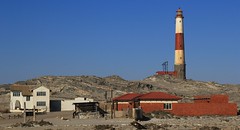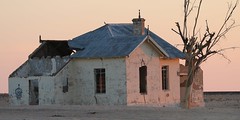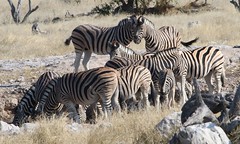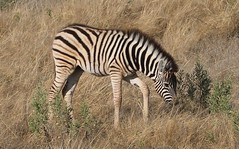África Austral : Photos
Descubram cada dias das Fotografias dos diferentes países da África e as Antilhas
Todas as imagens provêm do serviço de divisão de fotografia flickr
Utilizem a ementa de esquerda para escolher um país.
Shark Island Lighthouse Luderitz (1)
Richard Collier - Wildlife and Travel Photography posted a photo:
Pretoria (1)
Richard Collier - Wildlife and Travel Photography posted a photo:
Old Train Station - Namibia
Richard Collier - Wildlife and Travel Photography posted a photo:
Statue of Nelson Mandela - Pretoria (1)
Richard Collier - Wildlife and Travel Photography posted a photo:
A (330)
Girl with traditionally painted face from the Sakalava tribe, Nosy Be, Madagascar
Male Cape Baboon (Papio ursinus)
This chap was warily circling our 4 x 4 and our eatables spread on a collapsible table we had set up on a late afternoon stop during our game drive in Moremi...he was accompanied by about 20-25 smaller members of his troop, who were clearly less brave than he was!!
Plains Zebra (4)
Richard Collier - Wildlife and Travel Photography posted a photo:
Plains Zebra (6)
The safest way to cross a road, use a zebra crossing.
Plains Zebra (14)
Richard Collier - Wildlife and Travel Photography posted a photo:
Lily dancer!
A beautiful African Jacana walking (almost dancing) over the water lilies! Photo taken in the wild at Chobe, Botswana!
Somehow the photo is not as bright as on my laptop!
Copyright: Robert Kok. All rights reserved!
Please do not use my photos on websites, blogs or in any other media without my explicit permission.
Thanks for visiting, commenting and faving my photos. Its very much appreciated!
After The Kill: The Last Rays
Late one evening we tracked down this pride of lionesses right after the consumed their prey, bones and all. As you can see from their stomachs they can last for 3-4 days on this kill. There were no males in evidence, so they did not have to fight over the animal.
Female lions are the pride's primary hunters. They often work together to prey upon antelopes, zebras, wildebeest, and other large animals of the open grasslands. Many of these animals are faster than lions, so teamwork pays off.
After the hunt, the group effort often degenerates to squabbling over the sharing of the kill, with cubs at the bottom of the pecking order. Young lions do not help to hunt until they are about a year old. Lions will hunt alone if the opportunity presents itself, and they also steal kills from hyenas or wild dogs.
For more information: www.nationalgeographic.com/animals/mammals/a/african-lion/
After The Kill: The Last Rays
Late one evening we tracked down this pride of lionesses right after the consumed their prey, bones and all. As you can see from their stomachs they can last for 3-4 days on this kill. There were no males in evidence, so they did not have to fight over the animal.
Female lions are the pride's primary hunters. They often work together to prey upon antelopes, zebras, wildebeest, and other large animals of the open grasslands. Many of these animals are faster than lions, so teamwork pays off.
After the hunt, the group effort often degenerates to squabbling over the sharing of the kill, with cubs at the bottom of the pecking order. Young lions do not help to hunt until they are about a year old. Lions will hunt alone if the opportunity presents itself, and they also steal kills from hyenas or wild dogs.
For more information: www.nationalgeographic.com/animals/mammals/a/african-lion/
After The Kill: The Last Rays
Late one evening we tracked down this pride of lionesses right after the consumed their prey, bones and all. As you can see from their stomachs they can last for 3-4 days on this kill. There were no males in evidence, so they did not have to fight over the animal.
Female lions are the pride's primary hunters. They often work together to prey upon antelopes, zebras, wildebeest, and other large animals of the open grasslands. Many of these animals are faster than lions, so teamwork pays off.
After the hunt, the group effort often degenerates to squabbling over the sharing of the kill, with cubs at the bottom of the pecking order. Young lions do not help to hunt until they are about a year old. Lions will hunt alone if the opportunity presents itself, and they also steal kills from hyenas or wild dogs.
For more information: www.nationalgeographic.com/animals/mammals/a/african-lion/
After The Kill: Girls Dine out
For more detail, please click the screen
Late one evening we tracked down this pride of lionesses right after the consumed their prey, bones and all. As you can see from their stomachs they can last for 3-4 days on this kill. There were no males in evidence, so they did not have to fight over the animal.
Lion Prides and Hunting:
Female lions are the pride's primary hunters. They often work together to prey upon antelopes, zebras, wildebeest, and other large animals of the open grasslands. Many of these animals are faster than lions, so teamwork pays off.
After the hunt, the group effort often degenerates to squabbling over the sharing of the kill, with cubs at the bottom of the pecking order. Young lions do not help to hunt until they are about a year old. Lions will hunt alone if the opportunity presents itself, and they also steal kills from hyenas or wild dogs.
For more information: www.nationalgeographic.com/animals/mammals/a/african-lion/
After The Kill: Girls Dine out
For more detail, please click the screen
Late one evening we tracked down this pride of lionesses right after the consumed their prey, bones and all. As you can see from their stomachs they can last for 3-4 days on this kill. There were no males in evidence, so they did not have to fight over the animal.
Lion Prides and Hunting:
Female lions are the pride's primary hunters. They often work together to prey upon antelopes, zebras, wildebeest, and other large animals of the open grasslands. Many of these animals are faster than lions, so teamwork pays off.
After the hunt, the group effort often degenerates to squabbling over the sharing of the kill, with cubs at the bottom of the pecking order. Young lions do not help to hunt until they are about a year old. Lions will hunt alone if the opportunity presents itself, and they also steal kills from hyenas or wild dogs.
For more information: www.nationalgeographic.com/animals/mammals/a/african-lion/
After The Kill: Girls Dine out
Late one evening we tracked down this pride of lionesses right after the consumed their prey, bones and all. As you can see from their stomachs they can last for 3-4 days on this kill. There were no males in evidence, so they did not have to fight over the animal.
Lion Prides and Hunting:
Female lions are the pride's primary hunters. They often work together to prey upon antelopes, zebras, wildebeest, and other large animals of the open grasslands. Many of these animals are faster than lions, so teamwork pays off.
After the hunt, the group effort often degenerates to squabbling over the sharing of the kill, with cubs at the bottom of the pecking order. Young lions do not help to hunt until they are about a year old. Lions will hunt alone if the opportunity presents itself, and they also steal kills from hyenas or wild dogs.
For more information: www.nationalgeographic.com/animals/mammals/a/african-lion/
Grey-headed Bush-Shrike [(Malaconotus blanchoti]
Grey-headed Bush-Shrike [(Malaconotus blanchoti] chooses to be monogamous, selecting a life partner for breeding. However, it will find a new partner should the original mate die. Breeding is in summer when both birds contribute to the construction of the nest, usually found in the tree canopy. The female lays between 2 to 4 eggs, which are green in colour, and she alone incubates the eggs, while the male undertakes all the hunting and serves her food. Grey-headed Bush-Shrikes live singly or in pairs but never in flocks. Locally these birds enjoy living in woodlands feeding mainly on insects, but are also known to catch small snakes, lizards, bats and other bird. The species has a wide range through sub-Saharan Africa.
Lappetfaced Vulture [Torgos tracheliotus]
Lappet-faced vulture (Torgos tracheliotus)Lappet-faced vulture, the largest vulture in Africa the lappet-faced vulture dominates other vultures when feeding and is even powerful enough to fend off a jackal. This impressive, broad-winged bird is armed with a large and powerful beak capable of tearing off the hides, tendons and other coarse tissue of its scavenged prey, which are too tough for smaller scavengers. The lappet-faced vulture is easily recognised by its conspicuous size, bare, pink-skinned head and distinctive fleshy folds of skin, known as lappets, on the sides of its neck, for which it earns its common name.
BOTSWANA: ELEPHANTS
For a detailed closeup, just click the screen.
Mention the word refugees, and the image that comes to mind is that of humans that have been forced to leave their countries due to war, persecution or natural disaster. Botswana, a landlocked country in Southern Africa, is facing a different kind of refugee crisis – one caused by the hundreds of thousands of elephants that have fled their homelands to escape ruthless poachers.
This is not the first time the mammals have sought refuge at the Chobe National Park, an 11,700 sq. km (4,500 sq. miles) animal sanctuary located in northern Botswana. But Michael Chase, founder of Elephants Without Borders (EWB), who has been tracking the African elephants for the last twenty years, says this migration is different. In the past, the pachyderms used the sanctuary as a temporary home and always headed back to their respective countries after a few years.
However, since 2011, as poaching in Namibia, Zambia, and Angola, has escalated to new heights, the homeward migration has stopped. As of November 2016, over 130,000 elephants, roughly a third of the estimated 350,000 African elephant population, have made Botswana their permanent home. Chase says, “Elephants clearly have a cognitive ability to understand where they are threatened and where they are safe and in this case they are seeking refuge and sanctuary in Botswana where they are well protected.” (Source: Elephants Without Borders)
BOTSWANA: ELEPHANTS
For a detailed closeup, just click the screen.
Mention the word refugees, and the image that comes to mind is that of humans that have been forced to leave their countries due to war, persecution or natural disaster. Botswana, a landlocked country in Southern Africa, is facing a different kind of refugee crisis – one caused by the hundreds of thousands of elephants that have fled their homelands to escape ruthless poachers.
This is not the first time the mammals have sought refuge at the Chobe National Park, an 11,700 sq. km (4,500 sq. miles) animal sanctuary located in northern Botswana. But Michael Chase, founder of Elephants Without Borders (EWB), who has been tracking the African elephants for the last twenty years, says this migration is different. In the past, the pachyderms used the sanctuary as a temporary home and always headed back to their respective countries after a few years.
However, since 2011, as poaching in Namibia, Zambia, and Angola, has escalated to new heights, the homeward migration has stopped. As of November 2016, over 130,000 elephants, roughly a third of the estimated 350,000 African elephant population, have made Botswana their permanent home. Chase says, “Elephants clearly have a cognitive ability to understand where they are threatened and where they are safe and in this case they are seeking refuge and sanctuary in Botswana where they are well protected.” (Source: Elephants Without Borders)
Imagens automaticamente encarregadas desde flickr com para tags : (afriqueaustrale,southernafrica)






